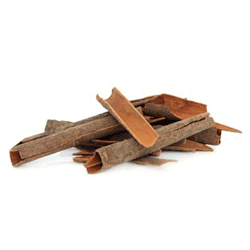Cinnamon trees belong to a large genus of some 250 species, most of which are aromatic. True Cinnamon is native to Sri Lanka, formerly known as Ceylon and the south-eastern coast of India, while the closely related Cassia is native to China
Contents
Uses
- Cinnamon bark is used for gastrointestinal (GI) upset, diarrhea, and gas. It is also used for stimulating appetite; for infections caused by bacteria and parasitic worms; and for menstrual cramps, the common cold, and the flu (influenza).
- Cinnamon bark, as part of a multi-ingredient preparation, is applied to the penis for premature ejaculation.
- In foods, cinnamon is used as a spice and as a flavoring agent in beverages.
- In manufacturing, cinnamon oil is used in small amounts in toothpaste, mouthwashes, gargles, lotions, liniments, soaps, detergents, and other pharmaceutical products and cosmetics.
Benefits
- Both Cinnamon leaves and bark are used for essential oil distillation, yielding two quite different products.
- Cinnamon bark contains mostly cinnamaldehyde (60%), while leaf oil consists mostly of eugenol (80%).
- The root bark is also sometimes distilled and yields up to 60% of camphor. Thus, these oils should not be used interchangeably.
- The bark oil is highly aromatic, with a sweet, spicy warming, typical Cinnamon scent.
- It has germicidal and fungicidal properties. Due to the high price of the pure oil, it is often adulterated with the cheaper leaf oil.
- Both oils can cause sensitization when applied directly to the skin, resulting in allergic dermatitis type of reactions.
Cautions
- Consuming cinnamon bark in food amounts is LIKELY SAFE. Cinnamon bark isPOSSIBLY SAFE for most people when taken by mouth in amounts used for medicine. These amounts are slightly higher than amounts found in food.
- However, cinnamon bark is POSSIBLY UNSAFE when taken by mouth in large amounts. Also, taking cinnamon oil by mouth is POSSIBLY UNSAFE. The oil can be irritating to the skin and mucous membranes, including the stomach, intestine, and urinary tract. It can cause side effects such as diarrhea, vomiting, dizziness, drowsiness, and others.
Interactions
- Medications for diabetes (Antidiabetes drugs) interacts with CINNAMON bark
- Cinnamon bark might decrease blood sugar. Diabetes medications are also used to lower blood sugar.
- Taking cinnamon bark along with diabetes medications might cause your blood sugar to go too low.
- Monitor your blood sugar closely. The dose of your diabetes medication might need to be changed.
- Some medications used for diabetes include glimepiride (Amaryl), glyburide (DiaBeta, Glynase PresTab, Micronase), insulin, pioglitazone (Actos), rosiglitazone (Avandia), chlorpropamide (Diabinese), glipizide (Glucotrol), tolbutamide (Orinase), and others.
Other names
Batavia Cassia, Batavia Cinnamon, Cannelier de Ceylan, Cannelle de Ceylan, Cannelle de Saïgon, Cannelle du Sri Lanka, Ceylon Cinnamon, Ceylonzimt, Ceylonzimtbaum, Cinnamomum verum, Cinnamomum zeylanicum, Corteza de Canela, Dalchini, Écorce de Cannelle, Laurus cinnamomum, Madagascar Cinnamon, Padang-Cassia, Panang Cinnamon, Saigon Cassia, Saigon Cinnamon, Sri Lanka Cinnamon, Thwak, Tvak
References
Sacredearth, http://www.sacredearth.com/ethnobotany/plantprofiles/cinnamon.php

